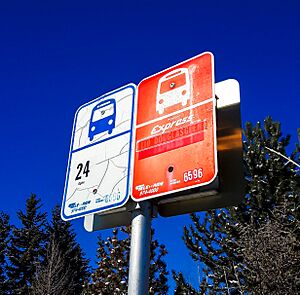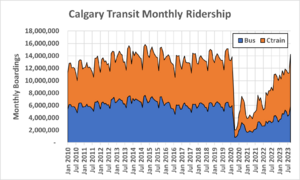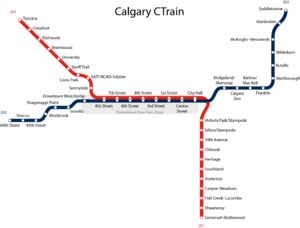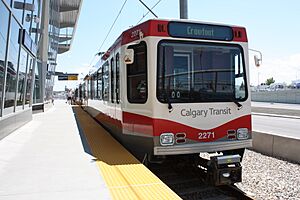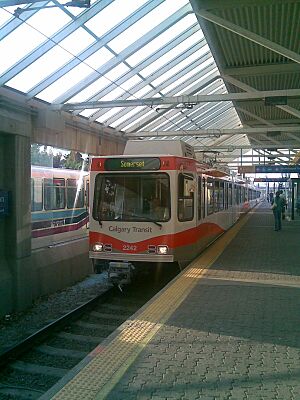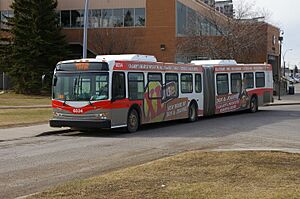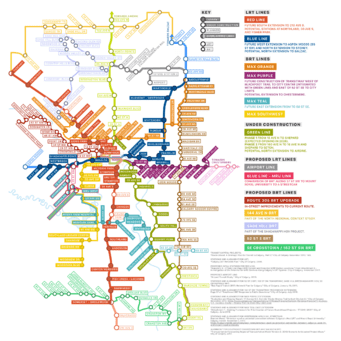Calgary Transit facts for kids
| Parent | City of Calgary Transportation Dept. |
|---|---|
| Founded | 1909 in its current form, 1884 to 1894 for the original Calgary Transit system. |
| Service area | Calgary, Alberta |
| Service type | Bus and light rail |
| Routes | 265 (147 regular, 116 school express, 2 LRT) |
| Stops | 6,151 |
| Stations | 45 LRT stations |
| Fleet | 1,101 buses 258 light rail vehicles |
| Daily ridership | 382,800 (weekdays, Q1 2023) |
| Fuel type | Bus: Diesel, Gasoline, CNG LRT: Electric (600 V DC) |
| Director | Sharon Fleming |
Calgary Transit is the main public transportation system in Calgary, Alberta, Canada. The city of Calgary owns and runs it. In 2019, over 106 million people rode Calgary Transit vehicles. It offers different ways to get around, like light rail trains (LRT), special fast buses (BRT), and regular buses.
Contents
History of Calgary Transit
Calgary Transit started as the Calgary Street Railway on July 5, 1909. It had twelve electric streetcars and served a city of 30,000 people.
The streetcar service grew for about 30 years. In 1946, the company changed its name to Calgary Transit System. Electric trolleybuses began to replace the streetcars. Later, these electric trolley lines were also replaced by diesel buses. In 1972, the system got its current name, Calgary Transit.
Between the 1970s and 2000, Calgary Transit had three types of bus services. Regular routes had white signs. "Blue Arrow" routes had blue signs and made fewer stops. "Express" routes had red signs and ran only during busy times. These special services have slowly changed. Calgary Transit now uses more CTrain lines and BRT services. The last Blue Arrow route stopped running in December 2019.
In 2012, Calgary Transit made a 30-year plan called 'RouteAhead'. This plan aimed to make Calgary Transit even better. On December 13, 2012, a rider named Craig Hardy became the one hundred millionth rider of the year. He received free transit for a year!
CTrain Light Rail System
Calgary Transit was one of the first cities in North America to have a light rail system. This system, called the CTrain, opened on May 25, 1981. Construction on it began in 1978. The first line, known as the Red Line (Route 201), ran from Anderson station in the south to 8th St SW in Downtown Calgary.
More CTrain lines opened over the years:
- April 27, 1985: The Blue Line (Route 202) opened, going northeast to Whitehorn station.
- September 4, 1987: A northwest line (part of Route 201) opened for the 1988 Winter Olympics. It went from downtown to University station.
Since then, many extensions and new stations have been added to the CTrain system. For example, in 2012, the West LRT opened with six new stations. This made the CTrain system 56.2 kilometers long.
Future plans include a new line called the Green Line. It will run from the north to the southeast parts of the city. Construction for parts of this line started in 2018.
On July 18, 2007, Calgary Transit introduced a new red and white design for its CTrains and buses. On February 18, 2009, Calgary Transit celebrated its one billionth rider!
Bus Rapid Transit (BRT)
On August 30, 2004, Calgary Transit started a bus rapid transit (BRT) line. BRT lines are designed to be faster than regular buses. They use special articulated buses, which are longer and can carry more people. The first BRT route was Route 301. Other routes like 305 and 302 were added later.
The BRT system is like an improved version of the older "Blue Arrow" service. Modern BRT buses get priority at traffic lights. They also have better waiting areas for passengers. This helps them travel faster and carry more people.
In 2009, the city approved the Calgary Transportation Plan (CTP). This plan identified over 20 areas for future fast transit. In 2011, the Bus Rapid Transit Network Plan was approved. It listed 11 BRT projects for the short, medium, and long term.
One of these projects was the Airport BRT, which became Route 300 in 2011. This route connects downtown with Calgary International Airport.
In November 2018, Calgary's BRT network got a big update. Three new lines were introduced under the "MAX" brand:
- MAX Orange (Route 303): Connects Brentwood Station with Saddletowne Station.
- MAX Teal (Route 306): Connects Westbrook Station with Douglas Glen Transit Hub.
- MAX Purple (Route 307): Connects downtown with East Hills using a special transitway. This was the first service in Calgary to have its own dedicated road.
In November 2019, the Southwest MAX line, renamed MAX Yellow, opened. It is the second bus service in Calgary to use a dedicated transitway. This route goes from downtown to Woodbine.
Bus Routes and Vehicles
Calgary Transit runs 147 regular bus routes and over 150 school or special routes. It uses more than 1,000 vehicles. All these buses are "low floor," meaning they are easy to get on and off. They are also wheelchair accessible and most have bicycle racks for bikes.
The bus fleet includes models like the New Flyer D40LF and Nova Bus LFS. Longer, articulated buses (60-foot) are also used for busy routes. Smaller "Community Shuttle" buses provide local service in some areas.
The CTrain system uses different types of light rail vehicles (LRVs). These include the original Siemens–Duewag U2 cars, Siemens SD-160s, and newer Siemens S200s. Many of the older SD160s have been updated with air conditioning and the new red and white design.
CTrains and busy bus routes usually run every 5 to 30 minutes. They operate from about 5 AM to 2 AM. Other bus routes run every 15 to 45 minutes. During busy times, there are also special rush hour routes.
Fares and Payment
Calgary Transit uses a single fare zone. This means the price is the same for all standard services, including buses, BRT, and the CTrain. As of January 2024, a single adult fare is $3.70, and for youth, it's $2.50. Children under 12 can ride for free!
You can buy books of 10 tickets or monthly passes. Monthly passes cost $115.00 for adults and $82.00 for youth. Seniors (65 and over) can get a yearly pass for $154.50. Sometimes, sponsors like Toronto-Dominion Bank offer free travel days, such as on New Year's Eve. TD also sponsors the Free Fare Zone downtown, where you can ride the CTrain for free along 7th Avenue.
When you transfer from one vehicle to another, you need proof of fare or a transfer ticket. This is valid for 90 minutes. Fare inspections happen on the CTrain to make sure everyone has paid.
Many post-secondary schools in Calgary offer a Universal Pass (U-Pass) program. Students pay for this pass as part of their school fees, and it lets them use transit.
MyFare App
In summer 2020, Calgary Transit launched its MyFare app for mobile phones. This app lets users buy most types of tickets and passes using a debit or credit card. Once you activate your ticket on the app, you scan your phone on buses. CTrain inspectors can also scan your phone to check your fare.
Transit Facilities
Calgary Transit has six main facilities. These places store and maintain the buses and trains. They also house different departments that keep the system running smoothly:
- Spring Gardens: Stores buses, has administration offices, and shops for repairs and training.
- Victoria Park: Stores buses, has a call center, and the control center for bus and rail operations.
- Anderson: Stores buses and trains, and has maintenance shops for both.
- Haysboro: Stores light rail vehicles (LRVs).
- Oliver Bowen: Stores LRVs and has maintenance shops for them.
- Stoney: Stores buses that run on natural gas (CNG) and has a fueling station for them.
Commuter Rail Experiment
In 1996, Calgary Transit tried a commuter train service for a short time. It ran from 162 Avenue SW to Anderson station. People could then transfer to the CTrain. This service was free and carried about 800 people a day. The trains ran on existing freight tracks. However, the city decided not to make it a permanent service. Later, the CTrain system was extended along the same path.
There have been talks about adding commuter train service to nearby towns like Airdrie and Cochrane. However, no firm plans have been made yet.



